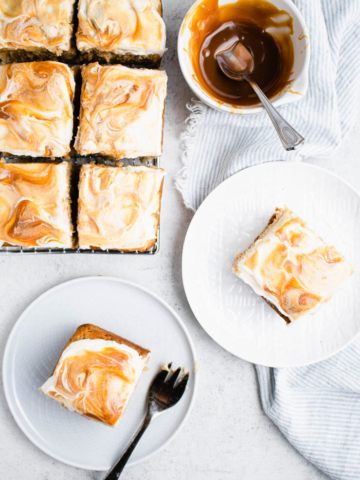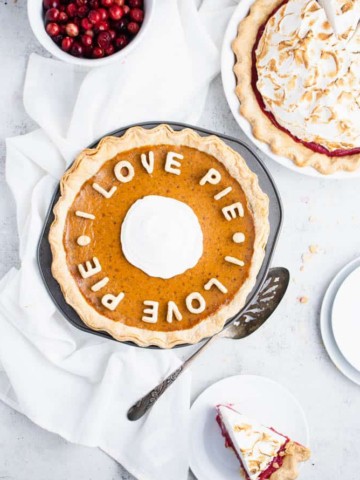Why should you learn how to brown butter? Sweet, nutty, and full of caramel flavors, browned butter is a quick and easy way to elevate your favorite treats using ingredients and tools you already have at home.

If there's one thing I can never get enough of, it's browned butter.
Sweet, nutty, and caramel flavor-laden, it's just a fact that browned butter makes everything better.
And - let's be real - taking your treats to new flavor heights doesn't have to be difficult or time-intensive; Browned butter can be made in less than 10 minutes with tools and ingredients you already have at home.
What I'm trying to say is I think you've earned a little treat, a treat with all the browned buttery goodness.
Jump to:
What is browned butter?
Browned butter is, in a word, heavenly. In its most basic form, it's made by cooking butter low and slow until the milk solids caramelize resulting in a sweet, slightly nutty flavor.
Chemically speaking, it's the result of a chemical reaction between amino acids and sugars known as the Maillard reaction.
Selecting butter

Normally I'd simply call this section "ingredients", but since there's only one, let's dive straight into the important part: How to select the best butter for browning.
In a nutshell, you want high-quality butter with a high percentage of fat - This will lead to a richer, deeper flavor and will melt faster. European butters like Kerrygold work well.
Unless otherwise directed by a recipe, you'll also want to select an unsalted butter (this allows you to control the overall saltiness of your dish).
How to brown butter

Slice the butter into ½" thick pieces to help it melt faster and more evenly.
Place in a small saucepan. I recommend using a light-colored pan (enameled cast iron or stainless steel works well) to make it easier to see the browning.

Place over low-medium heat. Because butter browns quickly (5-8 minutes from start to finish), it's important to keep the temperature low so it doesn't burn.
Cook, stirring regularly until the butter melts and the solids start to separate.

As the butter continues to cook, it will begin to sizzle, foam and deepen in color.
At this point, you'll want to stir constantly, both to keep it from burning and to move the foam around so you can keep an eye on the browning.

Continue cooking until golden brown flakes develop and the butter gives off a nutty aroma.
If you're having a hard time seeing through the foam, tilting the pan to one side can help.
Remove from heat and pour into a heatproof bowl to stop the cooking process.
Expert tips
- Start with room temperature butter: This reduces the splatter and helps it melt more evenly.
- Bringing cold butter to room temperature: One of the easiest methods is to cut it into ½" cubes and leave it on the counter for 10-15 minutes. You can also try one of these methods.
- Use a light-colored pan: This will ensure you can see the butter browning.
- Pay close attention: Cooking butter produces a froth that can be hard to gauge doneness through and goes from unbrowned to completely burned in a surprisingly short amount of time. Keeping a close eye on it will help you catch it at the right time.
- Cook at low-medium heat: Browning butter at a lower temperature can help it cook more evenly and reduce its chances of burning.

Troubleshooting
Sometimes the simplest recipes can be the hardest! Here are a few common browned butter problems and how to fix them:
- Overcooked: Should the butter become overcooked, you can pour it through a strainer to remove the burned flecks.
- Butter won't brown: Some stoves simply run hotter than others, so if your butter isn't browning, it may be that you need to turn the heat up just a little. Be sure to keep an eye on it so it doesn't become too browned.
Ways to use browned butter
Did you know you can substitute browned butter in almost any recipe that calls for butter? New level of deliciousness unlocked!
A couple of things to remember:
- Liquid evaporates from the butter as it browns so always measure it afterward to make sure you have the right amount.
- The evaporation of liquid can be problematic for recipes that require creaming butter. In those situations, browning half the butter may be a better option.
- If a recipe calls for cold or softened butter, you'll want to budget in time for the browned butter to cool/solidify before use.
Not ready to experiment on your own? Here are a few of my favorite recipes with browned butter already baked in:
Browned butter is also delicious in cookies, bars, and cakes.
Frequently asked questions
Perfectly browned butter will be a deep golden brown and have a slightly nutty aroma.
Generally speaking, yes. Just like regular butter, browned butter is safe at room temperature for no more than 1-2 days, and should be refrigerated to ensure it stays fresh and safe to eat.
Yes, browned butter that has solidified or been refrigerated/frozen can be melted in the microwave or over low heat on your stovetop.
Storage
Browned butter can be refrigerated in an air-tight container (a mason jar with a lid works particularly well) for up to 1-2 weeks.
It can also be placed in a sealable container and frozen for up to four months. Place in the refrigerator to thaw overnight.
Did you make this recipe? Please leave a ⭐ star rating and let me know how it went in the comments below! I regularly update these posts and feedback from wonderful readers like you help me improve them.
Recipe
How to Brown Butter
Sweet, nutty, and full of caramel flavors, browned butter is a quick and easy way to elevate your favorite treats using ingredients and tools you already have at home.
- Prep Time: 1 minute
- Cook Time: 8 minutes
- Total Time: 9 minutes
- Yield: ½ cup 1x
- Method: Cooking
- Cuisine: French
Ingredients
- ½ cup unsalted butter, at room temperature
Instructions
- Slice the room-temperature butter into ½" thick pieces.
- Place the butter into a small, light-colored saucepan. Place over low-medium heat.
- Cook, stirring regularly until the butter melts, the solids separate and the mixture develops a foam.
- Stirring constantly, continue cooking until golden brown bits form in the bottom of the pan and the butter gives off a nutty aroma.
- Remove from heat and pour into a heat-proof bowl.
Notes
-
- Start with room temperature butter: This reduces the splatter and helps it melt more evenly.
-
- Bringing cold butter to room temperature: One of the easiest methods is to cut it into ½" cubes and leave it on the counter for 10-15 minutes.
-
- Use a light-colored pan: This will ensure you can see the butter browning.
-
- Pay close attention: Cooking butter produces a froth that can be hard to gauge doneness through and goes from unbrowned to completely burned in a surprisingly short amount of time. Keeping a close eye on it will help you catch it at the right time.
-
- Cook at low-medium heat: Browning butter at a lower temperature can help it cook more evenly and reduce its chances of burning.
Keywords: how to brown butter, how to make brown butter, how do you brown butter, making brown butter, noisette butter









Sue says
Thank you for this detailed tutorial with pictures! I've never been sure how to brown butter, but I've read you can easily go from browned to burnt pretty quickly. And then you need to start over 😞
★★★★★